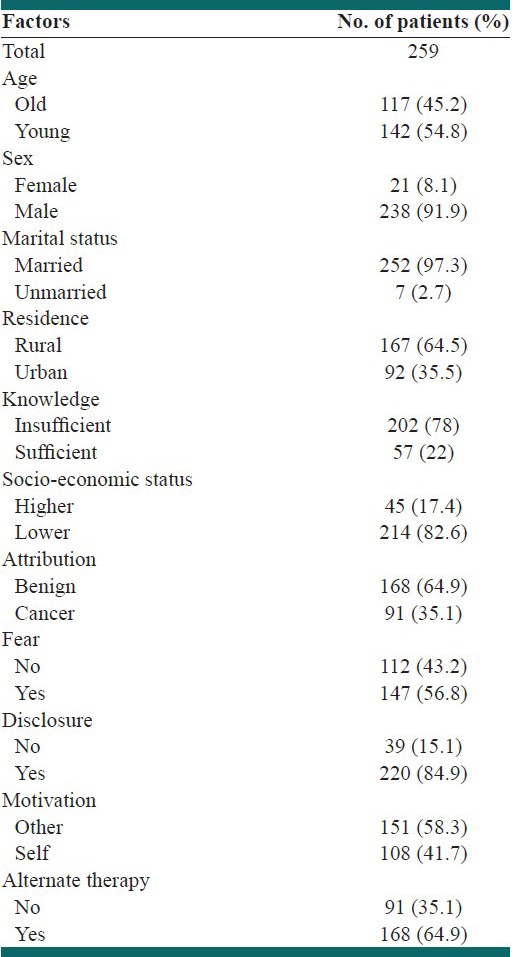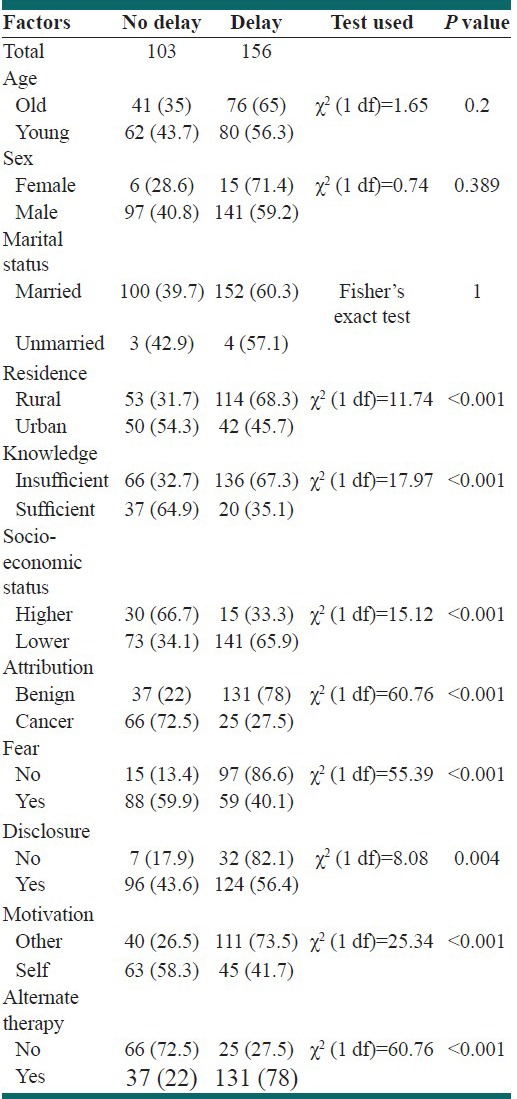Abstract
Background:
Delayed reporting resulting in advanced stage disease is a common problem in Indian cancer patients. This study analysed the impact of various sociodemographic and psychosocial factors on the delayed reporting to Healthcare Professional (HCP) in oral and oropharyngeal cancer patients.
Methods:
This cross sectional observational study was conducted using a structured questionnaire. Questionnaire included questions to assess socio-demographic and psychosocial factors associated with delay. Delay was defined as time intervals of more than 3 month from first symptom recognition to first medical consultation to a HCP. Association of delay with these factors was analyzed using logistic regression analysis.
Results:
Final analysis was done on 259 patients. Delay in reporting to HCP was present in 156 (60%) patients. Among sociodemographic factors delayed reporting was highly significant with older age group (P = 0.001), low socioeconomic status (P = 0.02), rural residence (P = 0.026) and with insufficient knowledge of Head and Neck cancer (P = 0.014). Sex and marital status were statistically insignificant factor for delay. Among psychosocial factors attribution of symptoms as minor (P = 0.011), absence of fear (P = <.001) and use of alternate therapy (P = 0.001) were significant factors responsible for delay. Disclosure to other and motivation were statistically insignificant in our study.
Conclusions:
The results of this study provide guidance towards interventions to reduce patient delay. Interventions should target the rural, older age group and lower socioeconomic population for educating them and to change their psychosocial behavior for oral and oropharyngeal cancer.
Keywords: Delayed reporting, Indian oral and oropharyngeal cancer patients, socio-demographic and psychosocial factors
INTRODUCTION
Oral and oropharyngeal cancer is a major form of cancer in India due to increased tobacco consumption habits.[1] Delayed reporting is a common problem in these patients and is responsible for advanced stage disease in most of these cases.[2] Delay can occur at three phases during the diagnostic process. Patient delay is the interval between the patient noticing a symptom and consulting a health care professional (HCP) doctor. Doctor or practitioner delay is the interval between first consultation and referral by a practitioner and finally, between referral and diagnosis (hospital or system delay).[3] Patient delay usually defined as intervals greater than 3 months and constitutes the largest proportion of the total delay period (30%).[4,5] Factors associated with patient delay can be grouped as clinical/tumor factors, patient socio-demographics factors, health care factors and psychosocial factors.[6] This study was aimed to identify socio-demographic and psychosocial factors associated with patient delay.
METHODS
This cross-sectional observational study was conducted at JN Medical College (Aligarh Muslim University), a government tertiary care hospital of northern India. All the patients of newly diagnosed and previously untreated squamous cell carcinoma of the oral cavity and oropharynx registered in out-patient department (OPD) between December 2010 and June 2012 were selected. Patients who have a prior consultation with HCP or/and referred by HCP were included. Incidentally diagnosed patients and patients not sure of the date of first symptom recognition were excluded. Study was explained and consent from each participant was taken. Delay was defined as time intervals of more than 3 months from first symptom recognition to first medical consultation to a HCP. Socio-demographic factors in the study included age, sex, marital status, area of residence and socio-economic status (SES). Age up to 50 years was considered as younger age group and beyond 50 years as older age group. SES was calculated using revised Kuppuswami scale 2010.[7] Score 15 and greater means upper and middle class (higher SES) and score less than 15 means lower class (lower SES).
A structured questionnaire was prepared to assess knowledge and beliefs about head and neck cancer[8] and psychosocial factors. Psychosocial factors in the Questionnaire included patients’ attributions of their symptoms, fear of symptoms, disclosing the discovery of symptoms to someone else, source of motivation for attending HCP as self or other and Use of alternate therapy.
Content validity of the questionnaire was established by doing a pilot study in a sample of 40 patients and then by consensus formed among a panel of experts. Reliability was estimated with a test-retest analysis of 30 patients within a 10 days interval. Questionnaire had excellent consistency, with intraclass coefficients equal to or greater than 0.75. Construct validity (internal consistency) was assessed through estimation of Cronbach's alphas for each questionnaire dimension. The questionnaire showed acceptable validity with Cronbach's alphas in the range of 0.51-0.68. Sample size was calculated based on the quality criteria proposed by Terwee et al.[9]
Based on this questionnaire, participants were interviewed in a single sitting by the trained staff of the department. Logistic regression analysis was used after modifying the effects of confounders to determine the significant factors responsible for delay. It was analyzed in arm package of R software (http://cran.r-project.org/web/packages/arm).
RESULTS
A total of 320 patients of newly diagnosed and previously untreated squamous cell carcinoma of the oral cavity and oropharynx were registered in our OPD between December 2010 and June 2012. After eligibility evaluation, 278 patients were included in the study. 19 patients did not return the questionnaire materials or gave incomplete response to the study questionnaire. Final analysis was performed on remaining 259 patients and data on these subjects are reported here.
The delay was found in 156 (60%) patients. The socio-demographic and psychosocial characteristics of study population are shown in Table 1. Association of these factors with delay is shown in Table 2. The independent effect of these factors on patient delay is described in Table 3.
Table 1.
Socio-demographic and psychosocial characteristics of the patients

Table 2.
Frequency table of different factors with delay

Table 3.
Logistic regression predicting delay

DISCUSSION
In our study delay was present in 155 (60%) patients. Among socio-demographics factors older age group, lower SES and rural residence were found to be significantly associated with delay. Sex and marital status were not found to be significantly associated with delay. Although some studies showed no association between socio-demographic factors such as age, sex and marital status and patient delay,[10] Llewellyn et al. in their study showed a positive association with being of a younger age group,[11] which is in contrast to our study.
Like some other studies[6,11] our study also found strong positive association between insufficient knowledge about Head and neck cancer and delay. Scott et al. identified lack of oral cancer knowledge as one of three independent predictors of patient delay.[12]
Oral symptoms are rarely attributed to cancer and are frequently interpreted as minor oral conditions. As a result of these beliefs, patients tend to postpone seeking help.[6] In this study, interpreting symptoms as “minor” or “not attributed to cancer” was significantly associated with delayed reporting to HCP.
Among the other psychosocial factors, absence of fear was significantly associated with delay in our study, but disclosing the symptoms to others and self-motivation were found to be statistically insignificant. Increase in fear level showed increased tendency toward earlier help-seeking but for low levels of fear, the picture is unclear.[13]
Delay associated with the use of alternate therapy is well-documented in the literature.[14,15,16] In India, use of alternative medicine could be attributed to the sheer ignorance and lack of primary health care facilities.[17] Kerdpon and Sriplung showed a positive association between the uses of herbal medication and delayed reporting to HCP.[18] In our study, use of alternate therapy was found to be a significant factor for delayed reporting to HCP.
The limitation of this study as also mentioned by Andersen et al. was the measurement of patient delay.[19]
CONCLUSIONS
The results of this study provide guidance toward interventions needed to reduce patient delay. The data indicate that interventions should target the rural, older age group and lower socioeconomic population for educating them and to change their psychosocial behavior for oral and oropharyngeal cancer.
Footnotes
Source of Support: Nil
Conflict of Interest: None declared
REFERENCES
- 1.Elango JK, Gangadharan P, Sumithra S, Kuriakose MA. Trends of head and neck cancers in urban and rural India. Asian Pac J Cancer Prev. 2006;7:108–12. [PubMed] [Google Scholar]
- 2.Brouha XD, Tromp DM, Hordijk GJ, Winnubst JA, de Leeuw JR. Oral and pharyngeal cancer: Analysis of patient delay at different tumor stages. Head Neck. 2005;27:939–45. doi: 10.1002/hed.20270. [DOI] [PubMed] [Google Scholar]
- 3.Andersen BL, Cacioppo JT. Delay in seeking a cancer diagnosis: Delay stages and psychophysiological comparison processes. Br J Soc Psychol. 1995;34(Pt 1):33–52. doi: 10.1111/j.2044-8309.1995.tb01047.x. [DOI] [PubMed] [Google Scholar]
- 4.Onizawa K, Nishihara K, Yamagata K, Yusa H, Yanagawa T, Yoshida H. Factors associated with diagnostic delay of oral squamous cell carcinoma. Oral Oncol. 2003;39:781–8. doi: 10.1016/s1368-8375(03)00075-7. [DOI] [PubMed] [Google Scholar]
- 5.Allison P, Franco E, Black M, Feine J. The role of professional diagnostic delays in the prognosis of upper aerodigestive tract carcinoma. Oral Oncol. 1998;34:147–53. doi: 10.1016/s1368-8375(97)00088-2. [DOI] [PubMed] [Google Scholar]
- 6.Scott SE, Grunfeld EA, Main J, McGurk M. Patient delay in oral cancer: A qualitative study of patients’ experiences. Psychooncology. 2006;15:474–85. doi: 10.1002/pon.976. [DOI] [PubMed] [Google Scholar]
- 7.Patro BK, Jeyashree K, Gupta PK. Kuppuswamy's socioeconomic status scale 2010-the need for periodic revision. Indian J Pediatr. 2012;79:395–6. doi: 10.1007/s12098-011-0517-7. [DOI] [PubMed] [Google Scholar]
- 8.Humphris GM, Duncalf M, Holt D, Field EA. The experimental evaluation of an oral cancer information leaflet. Oral Oncol. 1999;35:575–82. doi: 10.1016/s1368-8375(99)00040-8. [DOI] [PubMed] [Google Scholar]
- 9.Terwee CB, Bot SD, de Boer MR, van der Windt DA, Knol DL, Dekker J, et al. Quality criteria were proposed for measurement properties of health status questionnaires. J Clin Epidemiol. 2007;60:34–42. doi: 10.1016/j.jclinepi.2006.03.012. [DOI] [PubMed] [Google Scholar]
- 10.Scott SE, Grunfeld EA, McGurk M. Patient's delay in oral cancer: A systematic review. Community Dent Oral Epidemiol. 2006;34:337–43. doi: 10.1111/j.1600-0528.2006.00290.x. [DOI] [PubMed] [Google Scholar]
- 11.Llewellyn CD, Johnson NW, Warnakulasuriya S. Factors associated with delay in presentation among younger patients with oral cancer. Oral Surg Oral Med Oral Pathol Oral Radiol Endod. 2004;97:707–13. doi: 10.1016/j.tripleo.2004.01.007. [DOI] [PubMed] [Google Scholar]
- 12.Scott S, McGurk M, Grunfeld E. Patient delay for potentially malignant oral symptoms. Eur J Oral Sci. 2008;116:141–7. doi: 10.1111/j.1600-0722.2007.00520.x. [DOI] [PubMed] [Google Scholar]
- 13.Dubayova T, van Dijk JP, Nagyova I, Rosenberger J, Havlikova E, Gdovinova Z, et al. The impact of the intensity of fear on patient's delay regarding health care seeking behavior: A systematic review. Int J Public Health. 2010;55:459–68. doi: 10.1007/s00038-010-0149-0. [DOI] [PMC free article] [PubMed] [Google Scholar]
- 14.Davis GE, Bryson CL, Yueh B, McDonell MB, Micek MA, Fihn SD. Treatment delay associated with alternative medicine use among veterans with head and neck cancer. Head Neck. 2006;28:926–31. doi: 10.1002/hed.20420. [DOI] [PubMed] [Google Scholar]
- 15.Ernst E, Cassileth BR. The prevalence of complementary/alternative medicine in cancer: A systematic review. Cancer. 1998;83:777–82. doi: 10.1002/(sici)1097-0142(19980815)83:4<777::aid-cncr22>3.0.co;2-o. [DOI] [PubMed] [Google Scholar]
- 16.Patterson RE, Neuhouser ML, Hedderson MM, Schwartz SM, Standish LJ, Bowen DJ, et al. Types of alternative medicine used by patients with breast, colon, or prostate cancer: Predictors, motives, and costs. J Altern Complement Med. 2002;8:477–85. doi: 10.1089/107555302760253676. [DOI] [PubMed] [Google Scholar]
- 17.Agarwal AK, Sethi A, Sareen D, Dhingra S. Treatment delay in oral and oropharyngeal cancer in our population: The role of socio-economic factors and health-seeking behaviour. Indian J Otolaryngol Head Neck Surg. 2011;63:145–50. doi: 10.1007/s12070-011-0134-9. [DOI] [PMC free article] [PubMed] [Google Scholar]
- 18.Kerdpon D, Sriplung H. Factors related to delay in diagnosis of oral squamous cell carcinoma in southern Thailand. Oral Oncol. 2001;37:127–31. doi: 10.1016/s1368-8375(00)00072-5. [DOI] [PubMed] [Google Scholar]
- 19.Andersen RS, Vedsted P, Olesen F, Bro F, Søndergaard J. Patient delay in cancer studies: A discussion of methods and measures. BMC Health Serv Res. 2009;9:189. doi: 10.1186/1472-6963-9-189. [DOI] [PMC free article] [PubMed] [Google Scholar]


